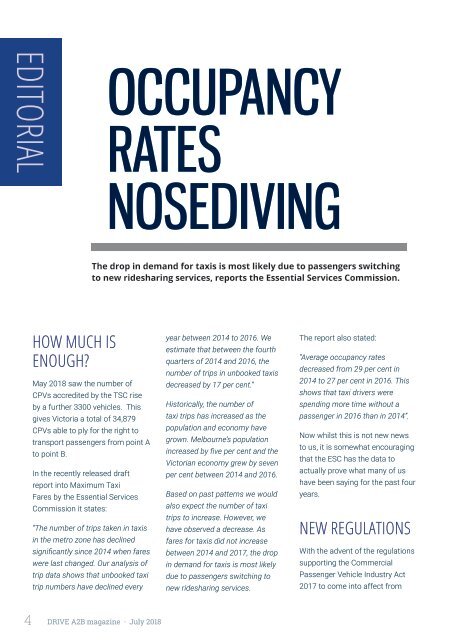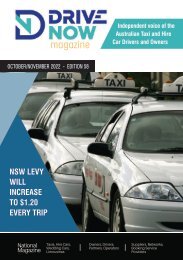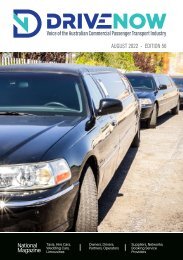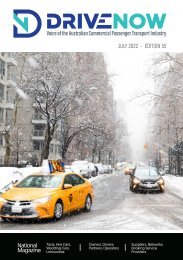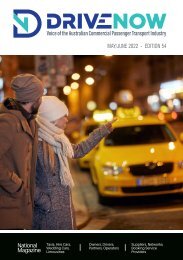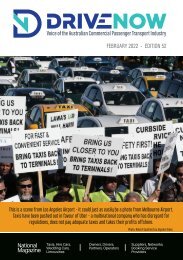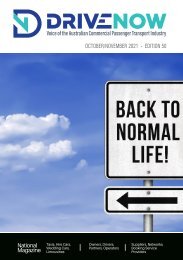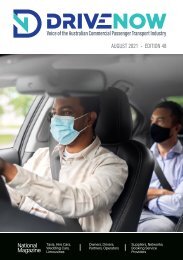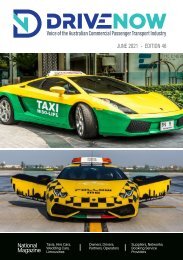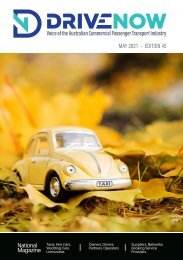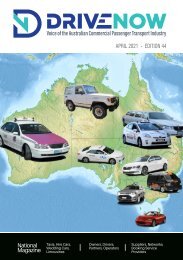DRIVE A2B July 2018
*** SCROLL DOWN TO SELECT ALTERNATIVE MAGAZINE EDITIONS *** Australia's only Magazine for the Commercial Passenger Transport Industry. News and views for Drivers, Owners and Operators of Taxi, Hire Car, Limousine, Ride Share, Booked Hire Vehicles, Rank and Hail Cars.
*** SCROLL DOWN TO SELECT ALTERNATIVE MAGAZINE EDITIONS ***
Australia's only Magazine for the Commercial Passenger Transport Industry.
News and views for Drivers, Owners and Operators of Taxi, Hire Car, Limousine, Ride Share, Booked Hire Vehicles, Rank and Hail Cars.
You also want an ePaper? Increase the reach of your titles
YUMPU automatically turns print PDFs into web optimized ePapers that Google loves.
EDITORIAL<br />
OCCUPANCY<br />
RATES<br />
NOSEDIVING<br />
The drop in demand for taxis is most likely due to passengers switching<br />
to new ridesharing services, reports the Essential Services Commission.<br />
HOW MUCH IS<br />
ENOUGH?<br />
May <strong>2018</strong> saw the number of<br />
CPVs accredited by the TSC rise<br />
by a further 3300 vehicles. This<br />
gives Victoria a total of 34,879<br />
CPVs able to ply for the right to<br />
transport passengers from point A<br />
to point B.<br />
In the recently released draft<br />
report into Maximum Taxi<br />
Fares by the Essential Services<br />
Commission it states:<br />
“The number of trips taken in taxis<br />
in the metro zone has declined<br />
significantly since 2014 when fares<br />
were last changed. Our analysis of<br />
trip data shows that unbooked taxi<br />
trip numbers have declined every<br />
year between 2014 to 2016. We<br />
estimate that between the fourth<br />
quarters of 2014 and 2016, the<br />
number of trips in unbooked taxis<br />
decreased by 17 per cent.”<br />
Historically, the number of<br />
taxi trips has increased as the<br />
population and economy have<br />
grown. Melbourne’s population<br />
increased by five per cent and the<br />
Victorian economy grew by seven<br />
per cent between 2014 and 2016.<br />
Based on past patterns we would<br />
also expect the number of taxi<br />
trips to increase. However, we<br />
have observed a decrease. As<br />
fares for taxis did not increase<br />
between 2014 and 2017, the drop<br />
in demand for taxis is most likely<br />
due to passengers switching to<br />
new ridesharing services.<br />
The report also stated:<br />
“Average occupancy rates<br />
decreased from 29 per cent in<br />
2014 to 27 per cent in 2016. This<br />
shows that taxi drivers were<br />
spending more time without a<br />
passenger in 2016 than in 2014”.<br />
Now whilst this is not new news<br />
to us, it is somewhat encouraging<br />
that the ESC has the data to<br />
actually prove what many of us<br />
have been saying for the past four<br />
years.<br />
NEW REGULATIONS<br />
With the advent of the regulations<br />
supporting the Commercial<br />
Passenger Vehicle Industry Act<br />
2017 to come into affect from<br />
4 <strong>DRIVE</strong> <strong>A2B</strong> magazine · <strong>July</strong> <strong>2018</strong>


